This post contains affiliate links, which means I may earn a commission if you purchase through those links (at no extra cost to you).
Learn the secrets to making Chipotle Cilantro Lime Rice in the comfort of your own kitchen. This copycat recipe starts with getting the right type of rice and cooking it in a non-traditional way. This rice is soft and fluffy with just the right amount of chew and no stickiness.

I’ve taken a deep dive into cooking perfect, fluffy rice on the stove or using a rice cooker. By using Basmati rice, and cooking it in lots of water (aka “the pasta method”), I was able to closely mimic their recipe.
You don’t have to use Basmati, though; I experimented with other kinds of rice and cooking methods and have outlined those as well.
Cilantro Lime Rice ingredients
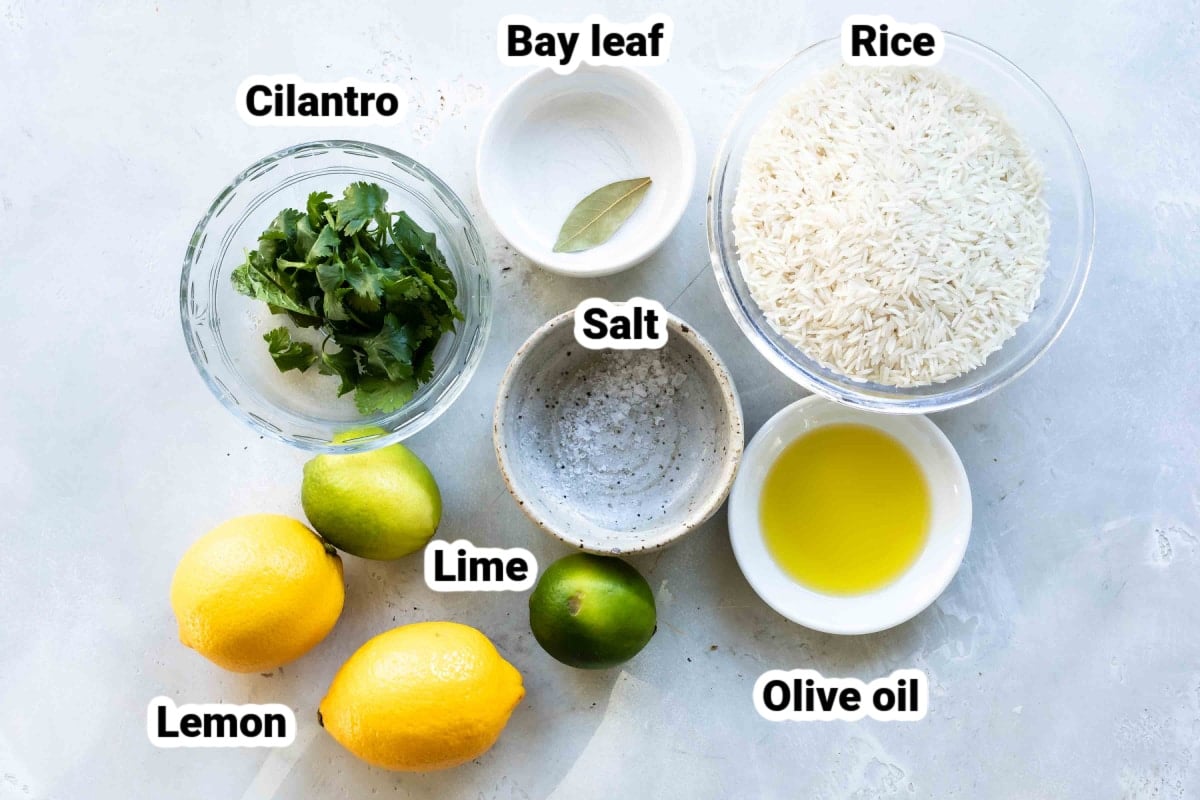
At a Glance: Here is a quick snapshot of what ingredients are in this recipe.
Please see the recipe card below for specific quantities.
“Grain” refers to the rice’s length-to-width ratio when cooked. More than likely, you’d be able to tell whether a rice is short-grain or long-grain just by looking at it. Medium is a tad more difficult because sometimes it gets lumped (clumped?) into the short-grain category.
- Short-grain rice is a plump, stubby grain. This rice is most commonly used for making sushi. Short-grain rice has more starch, so it clumps together easily.
- Long-grain rice is slender and long, as its name suggests. Varieties include American white and brown rice varieties, Jasmine rice, and Basmati rice. Long-grain rice has a firm, dry texture and is best for side dishes, pilafs, and salads.
- Medium grain rice is somewhere in between. It produces moist, tender, slightly chewy grains that stick to each other when cooked. Common medium-grain rices include Arborio and Valencia, which are used to make risotto, and Bomba rice, which is used in paella.
One thing I’ve definitely learned along the way is to use the type of rice listed in a given recipe. Each one has different characteristics, so if you swap in a kind that hasn’t been tested, you might not get the result you are hoping for.
How to make Chipotle Rice
Method 1: How to Make Perfect Basmati Rice on the Stove (pasta method)
Even though I had cooked Basmati rice before, I had always cooked it using the typical method we’ve all been taught: measure a specific ratio of rice to water, bring to a boil, cover, and cook until all the water has absorbed. Then I learned about a new (well, new to me) method for cooking Basmati rice, and it changed my rice-cooking life.
If you’ve always thought cooking rice was too tricky, this method is for you. It’s called the pasta method; if you can cook pasta, you can definitely make perfect rice.
- Bring 8 cups water to a boil in a large pot. Add rice, bay leaf, oil if using, and salt to taste (I like 2 teaspoons). Stir and return to a boil.
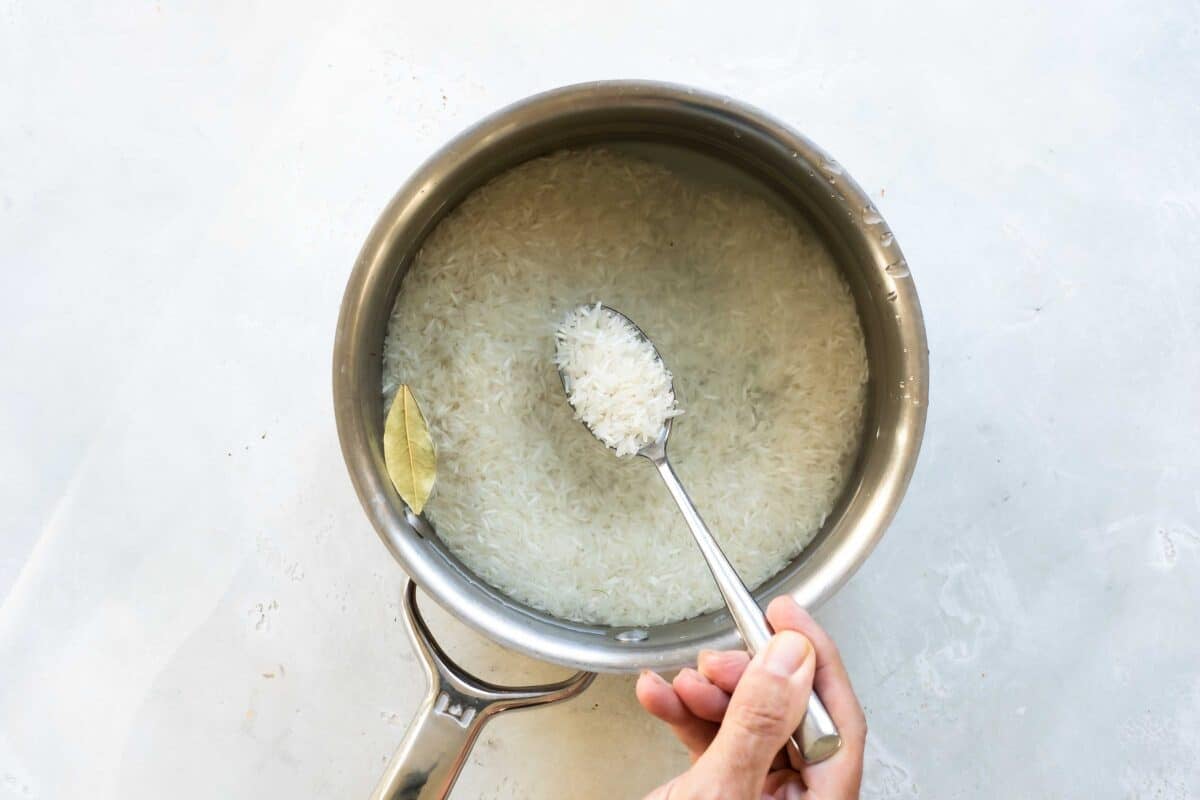
- Boil uncovered for 10 to 12 minutes (for me it’s always 12, but some readers have reported mushy rice after 12 minutes, so keep an eye on yours).
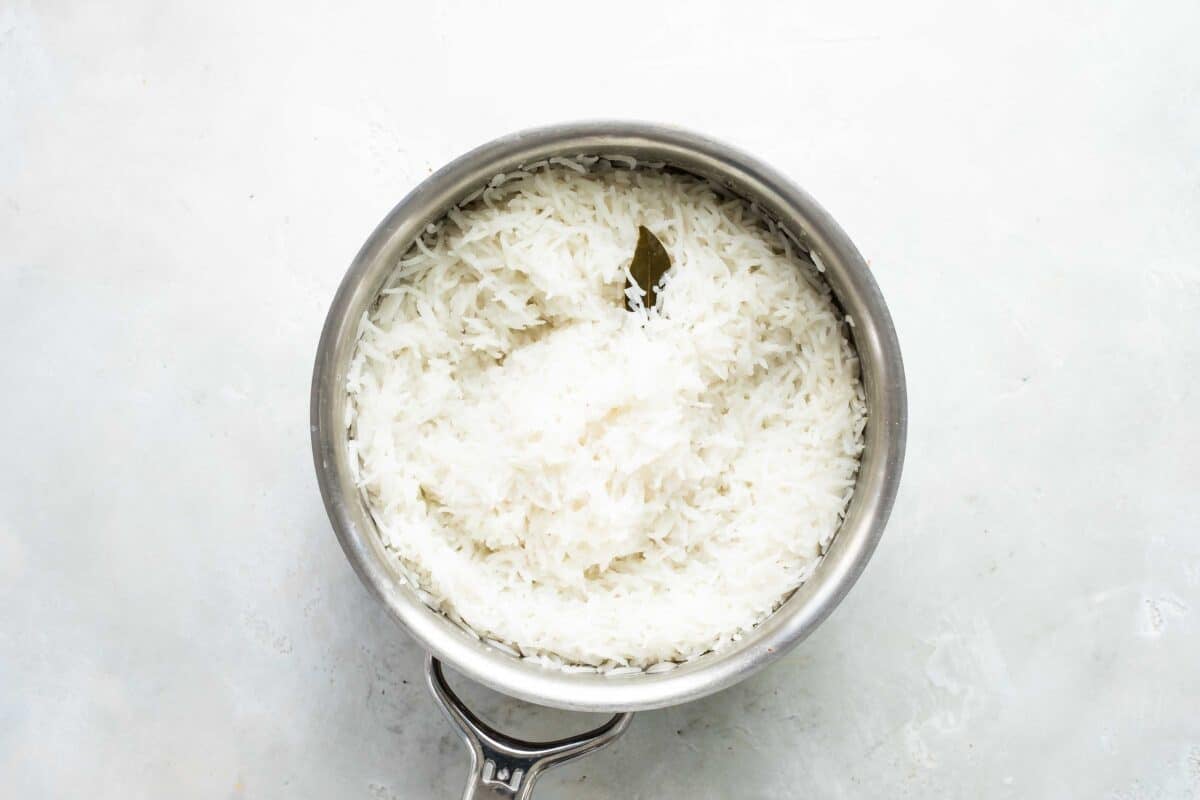
- Remove bay leaf. Using a fine mesh strainer, drain rice and rinse with hot water.

- Stir in cilantro, lime juice, and lemon juice. Season to taste with salt (I like an additional ¼ teaspoon). Serve hot or at room temperature.
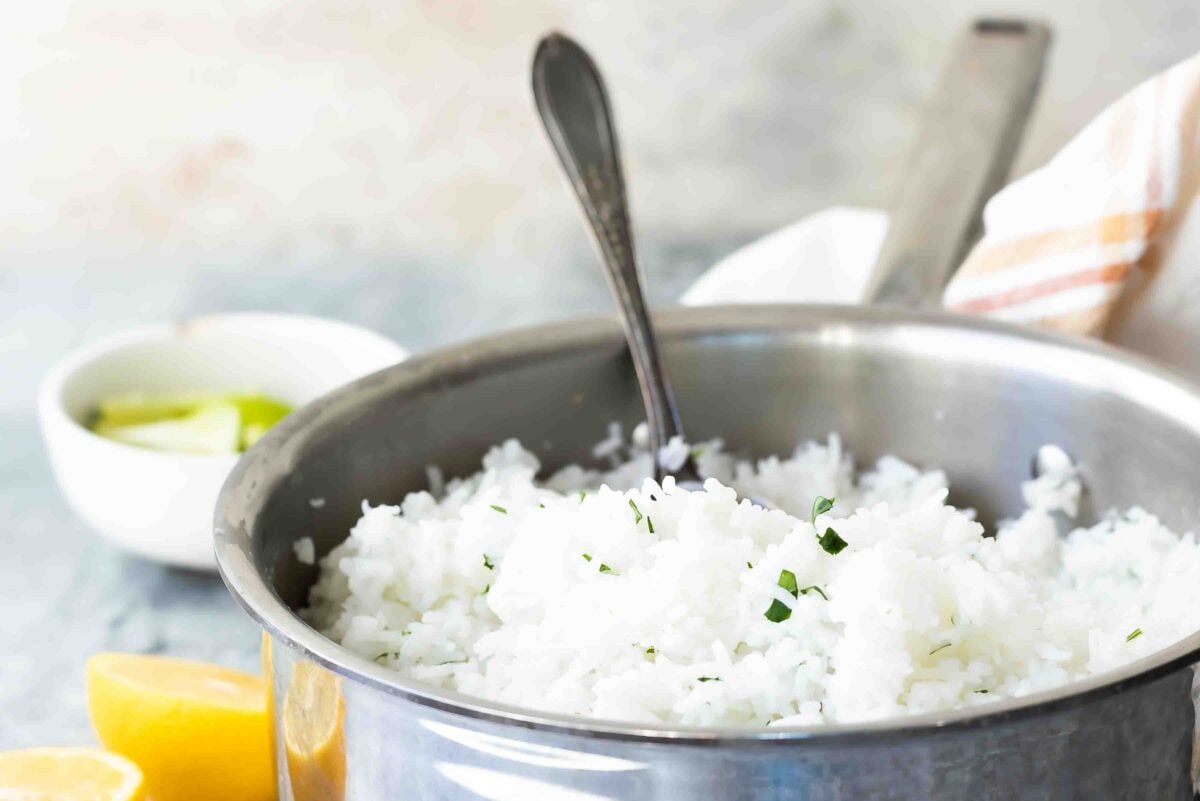
Method 2: How to Make Long-Grain Rice on the Stove (absorption method)
If you don’t have Basmati rice, you can still use another type of long-grain rice and still have a great version of Cilantro Lime Rice. I recommend rinsing it before cooking it to remove excess starch.
To rinse the rice, place it in a fine-mesh sieve under cool water and rinse until the water runs clear. Drain well before adding the rice to the pot or rice cooker. Or, soak the rice in a large bowl of water for up to 30 minutes to help remove starch while conserving water.
- Bring 4 cups water to a boil in a large pot. Add rice, bay leaf, oil if using, and salt to taste (I like 2 teaspoons). Stir and return to a boil.

- Reduce heat to low, cover, and cook for 15 minutes.

- Remove bay leaf. Stir in cilantro, lime juice, and lemon juice. Season to taste with salt (I like an additional ¼ teaspoon). Serve hot or at room temperature.
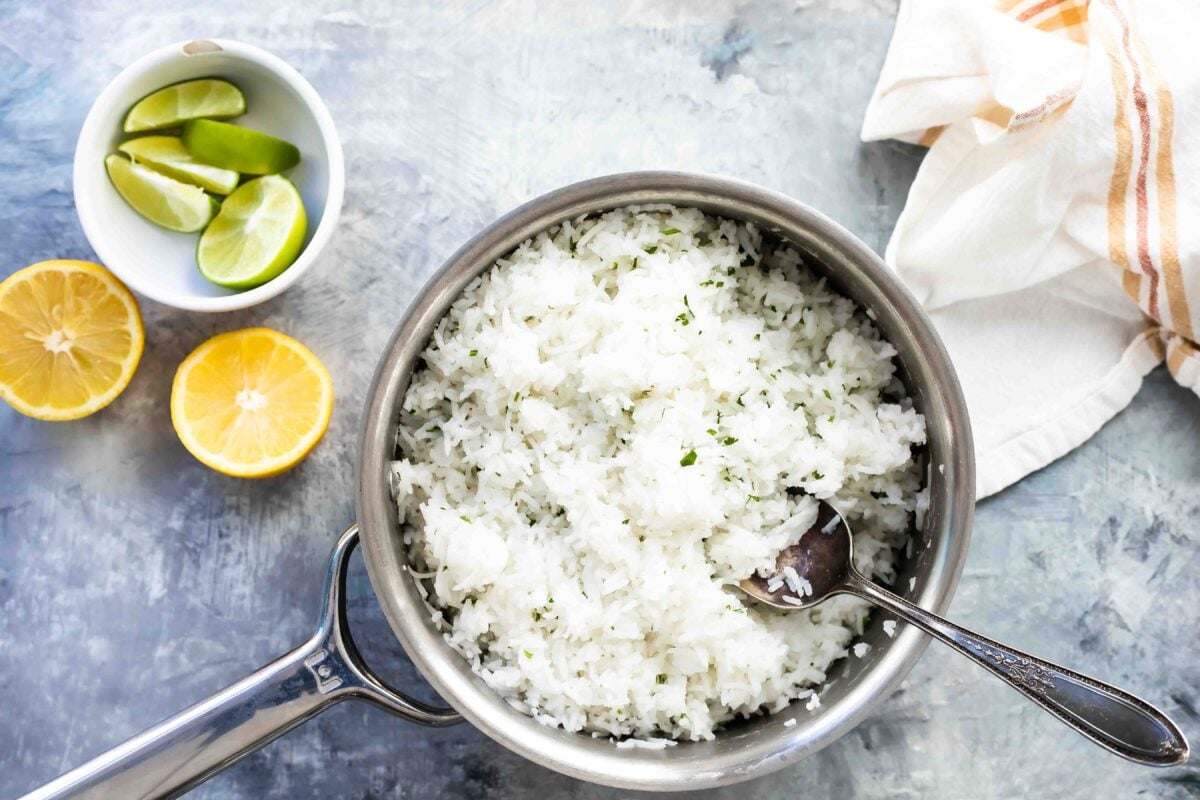
Method 3: How to make rice in a Rice Cooker
I love using a rice cooker! It’s completely hands-free and all I have to do is push a button. I use and recommend the Aroma Housewares Rice Cooker, which you can get on Amazon for $30. Rice cookers usually come with a measuring cup that’s a little smaller than a standard cup. You simply count out the number of cups you’re making, then fill the cooker with water up to the level on the side that matches the number of cups you’re making.
- Add rinsed rice, water (according to manufacturer’s instructions) bay leaf, salt (I like 1 teaspoon), and oil, if using. Close rice cooker, plug in, and turn on.
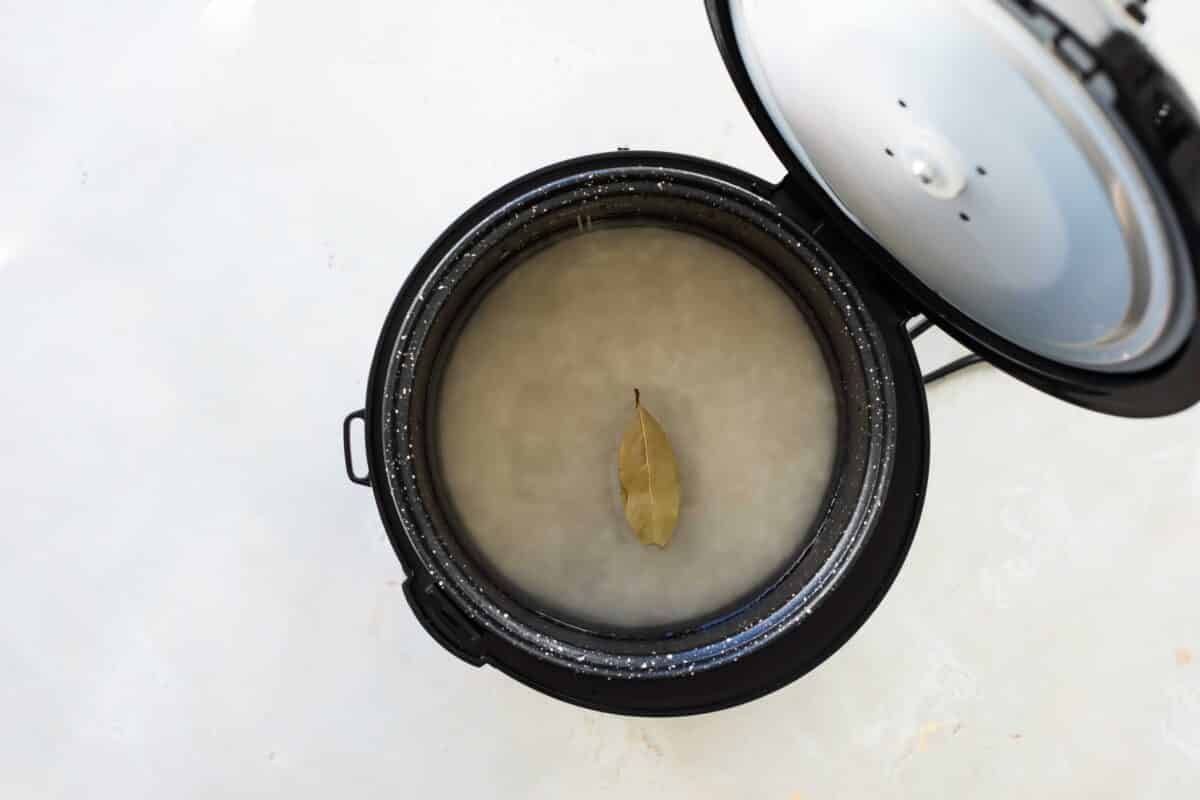
- Cook according to manufacturer’s instructions.
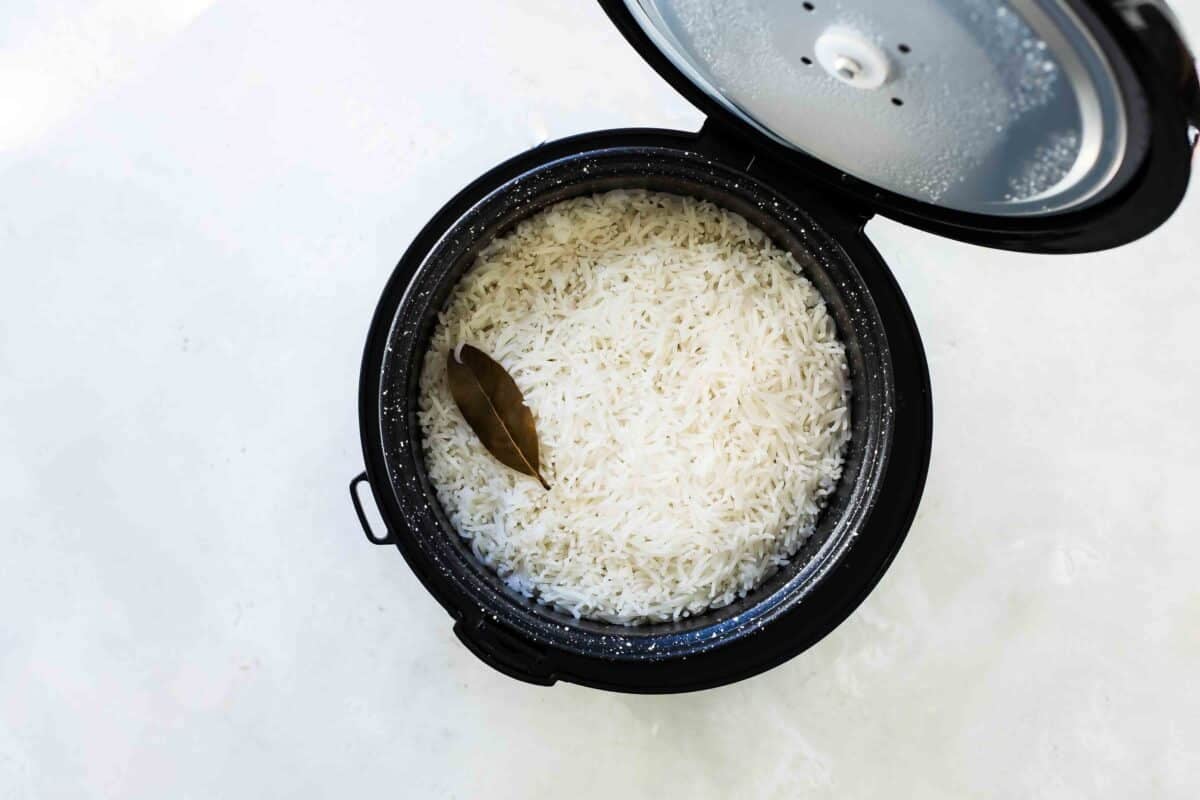
- When the rice is finished, remove bay leaf. Stir in cilantro, lime juice, and lemon juice. Add more salt to taste (I like ¼ teaspoon). Serve hot or at room temperature.

Method 4: Cilantro-Lime Brown Rice
You can cook Cilantro Lime Brown Rice in a rice cooker (easy, because most rice cookers have a ‘brown rice’ button) or on the stove top. I prefer to use brown Basmati rice, but any long-grain brown rice will do.
Because brown rice takes a little longer, just follow the revised cooking times as outlined in Step 7 of the recipe.

Recipe tips and variations
- Yield: 1 cup uncooked white rice makes 3 cups cooked white rice. 1 cup uncooked brown rice makes 4 cups cooked brown rice. This recipe will make about 6 cups of Cilantro-Lime Rice, enough for 12 (1/2-cup) servings. That means it’s great for plenty of burrito bowls and meal prep!
- Storage: Store leftovers covered in the refrigerator for up to 4 days.
- Freezer: Rice is one of the easiest things to freeze. I love to pack it into 2-cup portions (in plastic bags). Label, date, and lay flat in the freezer. Freeze for up to 3 months. Thaw as needed or add to soups or stir-fries straight from the freezer.
- Cilantro haters: If you happen to be one of the millions of people who despise cilantro (it’s not your fault), you can ask for rice without cilantro at Chipotle.
- Chipotle Burrito Bowls: Make your own copycat burrito bowls, tacos, and salads at home with my full collection of Chipotle Copycat Recipes:
- Proteins: Chipotle Chicken, Chipotle Steak, Chipotle Barbacoa, Chipotle Carnitas, Chipotle Sofritas
- Sides: Chipotle Cilantro-Lime Rice, Chipotle Black Beans, Chipotle Pinto Beans, Chipotle Fajita Veggies
- Sauces: Chipotle Guacamole, Chipotle Tomato Salsa, Chipotle Corn Salsa, Chipotle Tomatillo Salsa, Chipotle Hot Salsa, Chipotle-Honey Vinaigrette
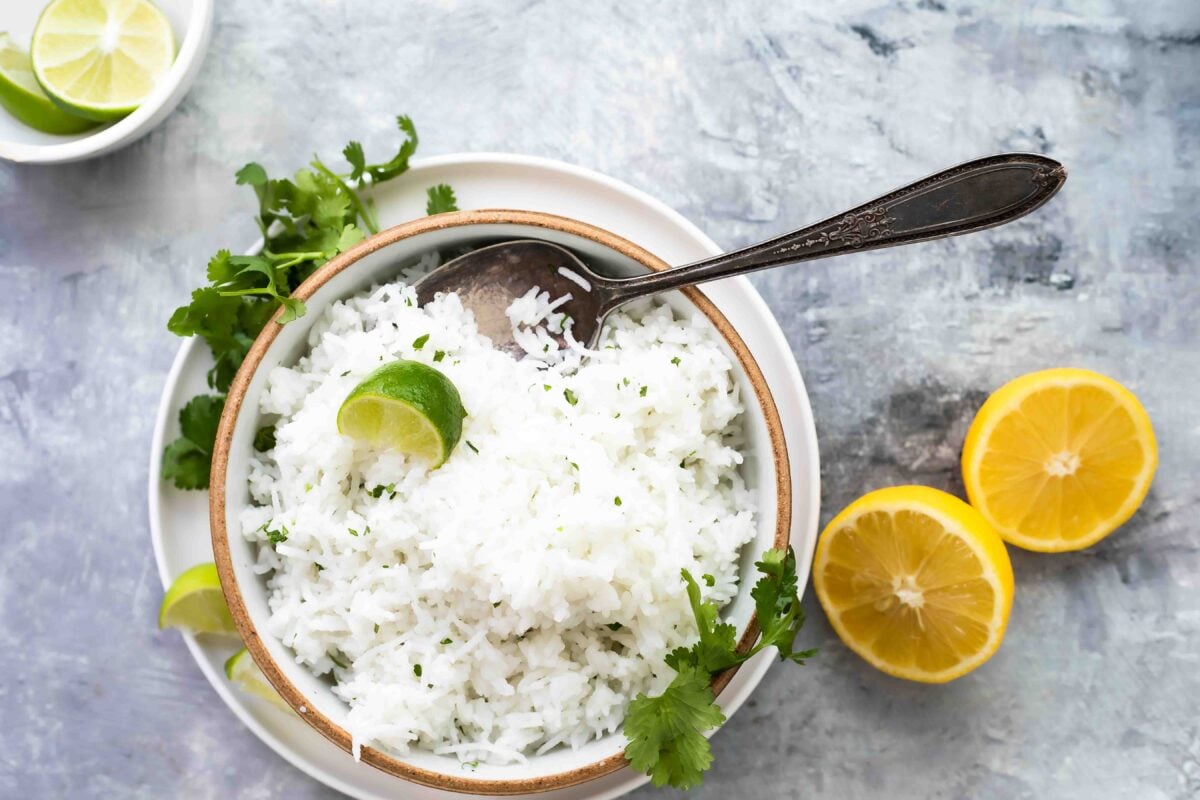
Why I love my rice cooker
I find that rice cookers help make the fluffiest rice and when we rounded up the best rice cookers, our top pick was my personal favorite: The Aroma Housewares Rice Cooker. It’s compact, super simple, and does exactly what it’s supposed to do without fail. My sisters, Erin and Meredith, each have the same one, and we all love it. Not to mention, it has over 6,100 positive reviews. That’s a whole lot of rice!
You can buy my favorite rice cooker for $42 at Target, or you can get the smaller 4-cup version for about $30 on Amazon.
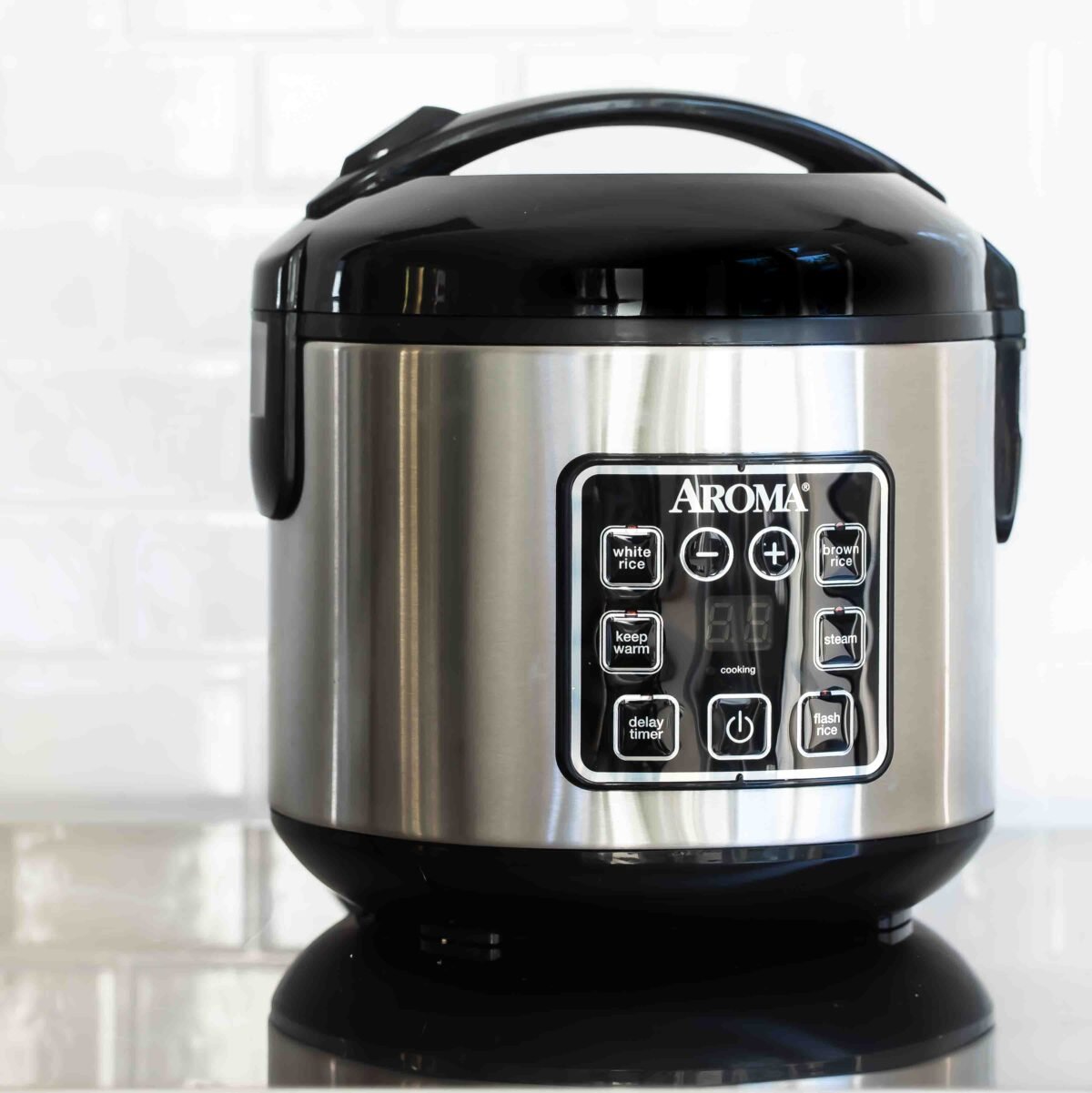
Rice cookers can cook polenta beautifully, also, without stirring it for a million hours. It’s not just a one-job appliance. And if you’re not sold on my rice cooker, others on our list have slow cooker capabilities, too.
Cilantro Lime Rice Recipe FAQs
1 cup uncooked white rice makes 3 cups cooked white rice. 1 cup uncooked brown rice makes 4 cups cooked brown rice.
Brown rice is considered a whole grain, with fibrous bran, germ, and all. Fiber, vitamins, and minerals are all stored in the bran and germ. White rice has had the bran and germ removed in processing, and so it’s technically less nutritious than brown rice. (But it’s still delicious!)
Brown rice takes quite a bit longer than white rice in terms of cooking, but instructions on how to make Cilantro Lime Brown Rice are in the recipe card below, in case you are interested.
Chipotle Copycat Recipes
Chipotle Chicken (Copycat)
Chipotle Copycat Recipes
Chipotle Steak (Copycat)
Chipotle Copycat Recipes
Copycat Chipotle Barbacoa
Chipotle Copycat Recipes
Chipotle Carnitas Copycat
More From Culinary Hill
Join Us
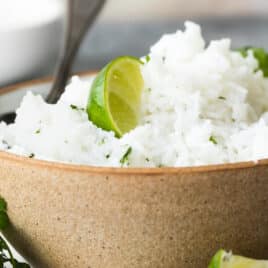
Cilantro Rice Recipe (Chipotle Copycat)
Equipment
- Rice cooker (optional; I own and recommend the Aroma Housewares Rice Cooker)
Ingredients
- 2 cups basmati rice unrinsed, or any long-grain white rice, rinsed (see note 1)
- 1 bay leaf
- Salt
- 1 teaspoon olive oil or rice bran oil, optional
- 2 tablespoons minced fresh cilantro (or omit or substitute parsley)
- 2 tablespoons lime juice
- 2 tablespoons lemon juice
Instructions
To cook basmati rice on the stove top:
- Bring 8 cups water to a boil in a large pot. Add rice, bay leaf, oil if using, and salt to taste (I like 2 teaspoons). Stir and return to a boil. Boil uncovered for 10 to 12 minutes (for me it's always 12, but some readers have reported mushy rice after 12 minutes, so keep an eye on yours).
- Remove bay leaf. Using a fine mesh strainer, drain rice and rinse with hot water. Pour into a large bowl.
- Stir in cilantro, lime juice, and lemon juice. Season to taste with salt (I like an additional ¼ teaspoon). Serve hot or at room temperature.
To cook any long-grain rice on the stove top:
- Bring 4 cups water to a boil in a large pot. Add rice, bay leaf, oil if using, and salt to taste (I like 2 teaspoons). Stir and return to a boil. Reduce heat to low, cover, and cook for 15 minutes.
- Remove bay leaf. Stir in cilantro, lime juice, and lemon juice. Season to taste with salt (I like an additional ¼ teaspoon). Serve hot or at room temperature.
To cook long-grain rice in a rice-cooker:
- Add rinsed rice (see notes), water (according to manufacturer's instructions, see notes), bay leaf, salt (I like 1 teaspoon), and oil if using. Close rice cooker, plug in, and turn on. Cook according to manufacturer's instructions.
- When the rice is finished, remove bay leaf. Stir in cilantro, lime juice, and lemon juice. Add more salt to taste (I like ¼ teaspoon). Serve hot or at room temperature.
To cook brown rice:
- Follow the instructions above using the following times: 40 minutes for Basmati on the stove top, 45 minutes for long-grain on the stove top, and 60 – 70 minutes for a rice cooker (or according to manufacturer’s instructions). 2 cups brown rice makes 16 servings, ½ cup each (higher yield than white rice).
Recipe Video
Notes
- Long-grain rice (not Basmati): If using a long-grain rice other than Basmati, I recommend rinsing it before cooking it to remove excess starch. To rinse the rice, place it in a fine-mesh sieve under cool water and rinse until the water runs clear. Drain well before adding the rice to the pot or rice cooker. Or, soak the rice in a large bowl of water for up to 30 minutes to help remove starch while conserving water.
- When using a rice cooker, it is important to follow the manufacturer’s instructions for rice and water portions. Many rice cookers come with a specific “measuring cup” that may not be equivalent to a standard 8-oz. cup. They will also specify exactly how much water to use in relation to their measuring cup for best results. Those instructions supersede my quantities of rice and water here, but the other ingredients should remain the same (subject to your own taste preference, of course). If you’re looking to buy a rice cooker, I use and recommend the Aroma Housewares Rice Cooker, which you can buy from Amazon.
- Yield: 1 cup uncooked white rice makes 3 cups cooked white rice. 1 cup uncooked brown rice makes 4 cups cooked brown rice. This recipe will make about 6 cups. Cilantro-Lime Rice, enough for 12 (1/2-cup) servings. That means it’s great for plenty of burrito bowls and meal prep!
- Storage: Store leftovers covered in the refrigerator for up to 4 days.
- Freezer: Rice is one of the easiest things to freeze. I love to pack it into 2-cup portions (in plastic bags). Label, date, and lay flat in the freezer. Freeze for up to 3 months. Thaw as needed or add to soups or stir-fries straight from the freezer.

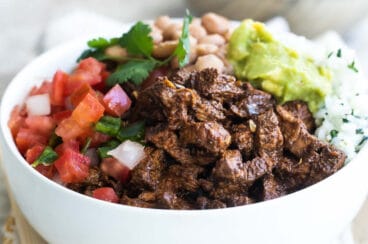

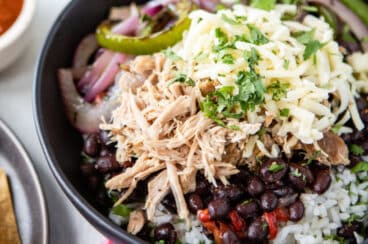
I’m not sure what happened, but this turned out WAY overpowered with lime or salt (or maybe both) when I made it for dinner. It was just a bit too much. I cut the recipe in half with the amount of rice I used, but I don’t know what happened. I am gonna try it again though!
I am so sorry about that, Jenn!!! Over salted food is the worst. It’s just not fixable! Here’s hoping your next attempt works out better. When you halved the rice, I assume you halved the salt/lime too?? 🙁
Hi! I just want to say that I use Minute Rice Premium Rice in a rice cooker and it works great! I just at lemon juice, lime juice and salt to taste. Add chopped cilantro, top with some mozzarella cheese and a little sour cream ( this is how my 5 year old devours it at Chipotle and at home!) Its great!! Pretty darn close to the real thing.
Bonnie, this is awesome! I really need to update the recipe to reflect more methods of preparation, and this is going on the list. Thank you so much for sharing your experience! Adding cheese and sour cream makes everything better… ha ha! My 3-year old loves the rice with their salad dressing on top. 🙂
I currently live outside the U.S. and I barely remember Chipotle… Now I can save myself the waiting in line cause this rice is amazing!! Perfect recipe, I followed it to a t (along with your black beans and chicken recipes- did the best I could with that one) and it was all really delicious. I don’t think I will ever cook rice with a lid again!
You are so sweet, thank you! The chicken gets easier with practice. I used to feel like – how will I ever make this! Now I can make it in my sleep. I also love that you get at least two batches out of it, that takes away some of the pain of the process. I love the rice too. I am working on a rice cooker method and also using regular long-grain rice. I think they are both good but I still like this original way the best (with no lid). Thank you so much for letting me know what you tried and how it went. It makes my day!
As for the rice, are there any nutrients left after this cooking process? Yikes!
Hi Jennifer, I assume this is a rhetorical question? 😉 Because no, probably not. It’s my understanding (based on reading the package the rice comes in), anytime you rinse rice at all, you are rinsing away whatever nutrients the rice was enriched with.
Hi Meggan,
Rice and masoor dal – called dal – chawal, are a staple in our culture. We eat them every single day, made from scratch every singly day!! We make varieties of flavored rice – atleast 12 and more in some regions of our country, and equal number of varieties of dal. Most if not all of these varieties call for fluffy, soft yet non-sticky rice. For generations people in our culture have been cooking rice uncovered on stove, a perfect make, every single time. As a matter of fact, the first thing young girls are taught to make in the kitchen is making perfect rice. I have never heard of rinsing the rice after it is cooked, though. That is interesting, however. I shall try that for today’s lunch. Your method of cooking rice and the choice of masoor dal to go with it, suggests, you have quite some expertise with Indian cuisine – both cooking and tasting! Keep up the good work of spreading joy!
Hi Esther, thank you so much for your comment! I am definitely no expert (at anything, never mind Indian cuisine!) but I struggled with making rice to my satisfaction for a long time until I found this method. If you do not normally rinse the rice, I will have to try leaving that step out myself again (I can’t remember if I tried it when I was working on this recipe). I love how you said that you have been cooking rice uncovered on a stove for generations… it seems so crazy to me and many others and yet it’s perfect every time. You have warmed my heart with your stories. Thank you so much.
What temperature are you cooking the rice at for 12 minutes. When i place it on low heat the boil slowly goes down. Would u recommend I keep it at medium heat ?
Hi David, sorry that wasn’t clear from the recipe! You’ll want to keep it at medium heat or even medium-high, whatever temperature is required to keep it boiling. I use a gas stove so medium heat works for me to keep it at a boil. On an electric stove it might be different, but probably not much. If you have any other questions please let me know!
Can I make this but with regular long grain white rice
Hi Jennifer, the technique I have outlined above (cooking with a ton of water, leaving the pot uncovered) won’t work with regular long-grain rice. If I were going to use regular rice, I would rinse it first to remove as much starch as possible (to prevent sticking) and then cook the rice according to the package directions. Chipotle uses regular long-grain rice so you should be able to, too! I just had better luck with the basmati. Good luck!
Tried this over the weekend and it came out perfect. Exactly like Chipotle. My new mission is to figure out how they make their pinto beans. Any ideas?
Hi Kristyn, I haven’t made their pinto beans myself, but here’s what I dug up from the site. I imagine it would take some trial & error to get it right. I’ve added that recipe to my to-do list! “Simmered with onions, garlic, oregano, and chipotle-chili adobo.”
Well well! I was googling for a cilantro rice recipe….and look what came up! Going on my dinner table tonight 🙂
The secret to fluffy rice, isn’t a lot of water. It’s cooking the raw rice first in oil, until the rice is clear, then adding in twice as much water by volume as rice, salt and any seasoning you want IN the rice, such as a bay leaf. Bring to a boil, then stick the lid on, reduce your heat to low for 15 minutes, then turn off the heat and let it steam for 15 minutes. Open, use a fork to fluff the rice, none of it sticks, and there’s no draining, or rinsing.
I could see this method being very effective because you cook the rice first in oil which would prevent sticking. I have a few baked rice dishes that start that way and it always yields fluffy, individual grains. Great method!